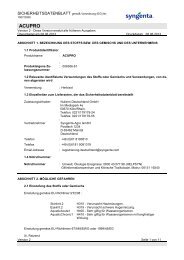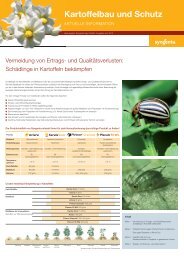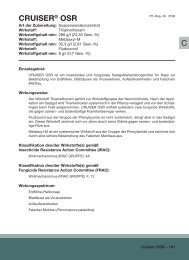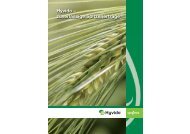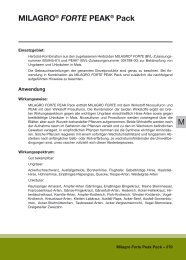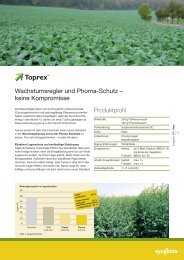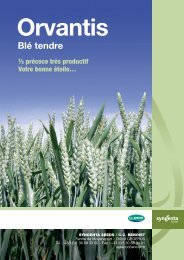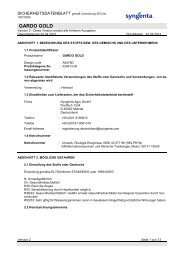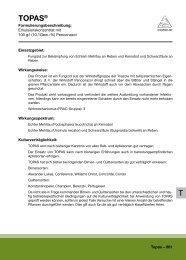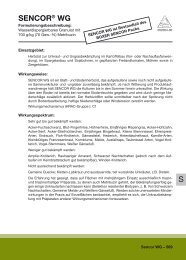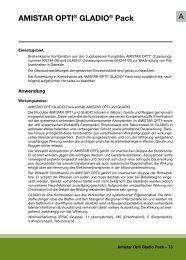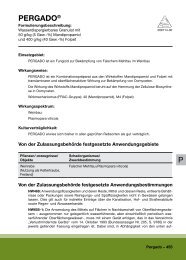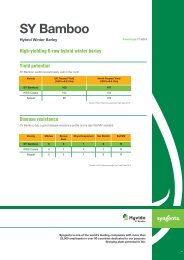Brochure Pdf - Syngenta
Brochure Pdf - Syngenta
Brochure Pdf - Syngenta
Create successful ePaper yourself
Turn your PDF publications into a flip-book with our unique Google optimized e-Paper software.
Spinach (Baby leaf)El RealBenefits● Dark green very upright variety especially for the baby leaf market● Strong colour, shiny glossy leaves● Flexible leaves for washingASSORTMENT TABLE SPINACH (BABY LEAF)VarietyColourResistances(PFS)PlantingrecommendedforUseShort descriptionIndurainMid greenHR: 1-8,11-13Spring/AutumnBaby/Teenfresh marketVery reliable round-leaf variety for babyleaf.El RealDark greenHR: 1-12IR: 13Spring/AutumnBaby/Teenfresh marketDark green very upright variety especially for the babyleaf market. Strong colour, shiny glossy brillinat leaves .El Cajon Dark greenHR: 1-12IR: 13SummerBaby/Teenfresh marketMedium speed variety with round leaves, close to el patriot;main stream babyleaf and industry market dual purpose.El ToroMid greenHR: 1-12IR: 13Spring/AutumnBaby/Teenfresh marketSemi-savoy medium upright variety for babyleaf/teens.Uniform with good growth vigour.RubiaMid greenwith redveinsHR: 1-8,11-13Spring/AutumnBaby/Teenfresh marketOne of the slowest red-veined varieties on the market,red colour is strongest in spring and autumn<strong>Syngenta</strong> Seeds LtdCPC4 Capital Park, Fulbourn, Cambridge CB21 5XETel: 0845 602 5239 • Fax: 01223 882238© Copyright 04, 2011 <strong>Syngenta</strong> Seeds B.V.® Registered trade mark of a <strong>Syngenta</strong> Group CompanyOctober 2011www.syngenta-crop.co.uk
Diseases in LettucePests & DiseasesLEAF MINERLETTUCE APHIDPOTATO APHIDGREEN PEACHAPHIDDLRDLRLIRIOMYZA SPEC.Attacks by leaf minersare common under glassbut more infrequentoutdoors. In addition toliking lettuce, leaf minersfeed on cucumbers,tomatoes, peppers andvarious ornamental plants.The larvae cause gentlywinding, serpentine-likemining patterns on theleaves. In cases of intenseinfestation leaf loss canoccur.NASONOVIA RIBISNIGRINasonovia prefers to suckon heart leaves. In additionto the physical leaf damagewhich it immediately causesthrough sucking, this pestalso causes honeydewcontamination andsubsequently sooty mould.Complete freedom fromthese aphids can only beachieved through the use ofa combination of Nasonoviaresistantlettuce varieties andinsecticides (seed treatmentsand foliar applications).AULACORTHUM SOLANIThe potato aphidgenerally overwinters ingreenhouses. In additionto liking lettuce, it likes tofeed on numerous arablecrops, such as varieties ofvegetable and ornamentalplants grown both outdoorsand under glass. Crimpingand deformities occur ifyoung leaves are attacked.Secondary damage as aresult of the transmissionof viruses is a commonproblem.MYZUS PERSICAEThese heterophagousaphids suck on the heartleaves of plants,as wellas leaf damage andstunted growth, theyproduce honeydew andsubsequently sooty mould.Furthermore, Myzuspersicae is also consideredto be a virus carrier. It istherefore imperative thattimely action is takenagainst this pest on itsfirst appearance.GREY MOULDDOWNY MILDEWBOTTOM ROTWHITE MOULDDLRBOTRYTIS CINEREAThe fungus infects plantsvia points of damageand through weakenedplant tissue. A grey fungalfilm rapidly forms on theaffected plant parts (leaves,stalks). The plant thenstarts to rot and dies off.Grey mould rot usually setsin shortly after planting orbefore harvest.DLR = Copyright by DLR Rheinland-PfalzBREMIA LACTUCAEBremia can infect lettuceat any time during itsperiod of culture and preferhigh levels of humidityor water when doing so.The fungus displays ahigh level of variability,constantly develops newpathotypes and thereforecould break down theresistance of the lettucevarieties.RHIZOCTONIA SOLANIThis rot occurs most oftenin lettuce growing undercool, damp conditions.The outer leaves of thehead which are lying on theground, rot and becomebrownish-black in colour.Heads of lettuce thathave been attacked canthen only be sold once asubstantial amount of timeand effort has been put intotrimming them.SCLEROTINIASCLEROTIORUMSclerotinia first infectslettuce plants via the outerleaves through mycelia.The rot then rapidly expandsto cover the whole plantand can lead to thecomplete loss of the plant.The fungus, in the formof sclerotia in the ground,outlives the plant for avery long time. Measuresfor combating this mouldshould be taken onbedding out or shortly afterplanting and may need tobe repeated.<strong>Syngenta</strong> Seeds LtdCPC4 Capital Park, Fulbourn, Cambridge CB21 5XETel: 0845 602 5239 • Fax: 01223 882238© Copyright 04, 2011 <strong>Syngenta</strong> Seeds B.V.® Registered trade mark of a <strong>Syngenta</strong> Group CompanyOctober 2011www.syngenta-crop.co.uk
Diseases in LettuceCrop Protection ProductsCropGrowth stageWatervolume l/haBest nozzle Low drift option NotesLettuceSmall open 100-200 AMISTAR nozzle AMISTAR nozzleHearted 300-80065-06 or 08 <strong>Syngenta</strong>vegetable nozzle110˚ Air inductionRun-off is the enemyof small plantsBENEFITS:Highly specific against aphidsMultiple modes of actionExcellent environmental profileAn essential part of an IntegratedCrop Management programmeBENEFITS:Zeon micro-capsule formulationImproved foliar persistenceExcellent aphid knockdownand repellencyWater based formulationSuperior rainfastnessApproved for an unrivalled rangeof crops and insect pestsAPHOX ®, HALLMARK with ZEON TECHNOLOGY® are Registered Trademarks of a <strong>Syngenta</strong> GroupCompany. APHOX contains pirimicarb (MAPP 10515), HALLMARK with ZEON TECHNOLOGY containslambda-cyhalothrin (MAPP 12629). All other brand names used are Trademarks of other manufacturersin which proprietary rights may exist. HALLMARK with ZEON TECHNOLOGY will be referred to asHALLMARK ZEON throughout this brochure. ALWAYS READ THE LABEL. USE PESTICIDES SAFELY.Powdery and downy mildew cancycle through a generation inonly a few days and the multiplegenerations that may occur in onecrop increase the potential for thepathogens to overcome both geneticand fungicidal protection methods.For this reason, a robust strategyemploying both means of control isessential to preserve their long termeffectiveness. The first line of defenceis genetic, and varietal choice shouldinclude consideration of resistancegenes in relation to the strainspredominating within your locality.However, varietal resistance mustbe supported with a sound fungicidestrategy to minimise disease pressureon the genetics and equally maintaineffectiveness of the fungicides.AMISTAR nozzle 06 Vegetable nozzle 08 Vegetable nozzle<strong>Syngenta</strong> Seeds LtdCPC4 Capital Park, Fulbourn, Cambridge CB21 5XETel: 0845 602 5239 • Fax: 01223 882238© Copyright 04, 2011 <strong>Syngenta</strong> Seeds B.V.® Registered trade mark of a <strong>Syngenta</strong> Group CompanyOctober 2011www.syngenta-crop.co.uk
Planting AdviceLettuceVARIETY COLOUR CHARACTERISTICS RESISTANCES PLANTING WEEKBellagio OutdoorBl(HR)Nr: 0(HR)9 10 11 12 13 14 15 16 17 18 19 20 21 22 23 24 25 26 27 28 29 30 31 32 33 34 35Rodagio(LS9429)Red/GreenBred to meet theneeds of the freshcut industry. One-cutlettuce producinga high number ofeven-sized leaves andminimal waste. Goodfield holding and yield.1-28IcebergBl(HR)Nr: 0(HR)9 10 11 12 13 14 15 16 17 18 19 20 21 22 23 24 25 26 27 28 29 30 31 32 33 34 35IcedukeGreenFast maturing varietysuited to earlyseason use.1-25,27-28Challenge GreenRomaine and GemThe standard Icebergvariety for summerproduction.Bl: 1-7,10, 13-15, 17,21, 27Bl(HR)Nr: 0(HR)9 10 11 12 13 14 15 16 17 18 19 20 21 22 23 24 25 26 27 28 29 30 31 32 33 34 35MusenaGreenUpright well-filledheart. Strong againstbolting. Strong againsttwisting. Multi-purposevariety.1-18,20-24,27-28VictosGreenVigorous little Gem forthe spring period.11-24,27-28ActinaGreenMidi Romaine suitablefor whole head, heartsand processing.1-28 Mordore(LS8876)Red/GreenMini red Cos withred outer leaves andcontrasting red topsto brilliant green innerleaves. Suitable forwhole season use.1-28BataviaBl(HR)Nr: 0(HR)9 10 11 12 13 14 15 16 17 18 19 20 21 22 23 24 25 26 27 28 29 30 31 32 33 34 35FunfixVigorous variety withvery uniform heads1-28FuntasiaAttractive variety andhealthy characteristics1-28<strong>Syngenta</strong> Seeds LtdCPC4 Capital Park, Fulbourn, Cambridge CB21 5XETel: 0845 602 5239 • Fax: 01223 882238© Copyright 04, 2011 <strong>Syngenta</strong> Seeds B.V.® Registered trade mark of a <strong>Syngenta</strong> Group CompanyOctober 2011www.syngenta-crop.co.uk
Planting AdviceEndiveVARIETY CHARACTERISTICS PLANTING WEEKScarole 9 10 11 12 13 14 15 16 17 18 19 20 21 22 23 24 25 26 27 28 29 30 31 32 33 34 35BrillantesArmantes(ES8217)Green Scarole. High volumeand weight. Good heart fillingand bolting tolerance.Green Scarole for summerproduction.Intermediate 9 10 11 12 13 14 15 16 17 18 19 20 21 22 23 24 25 26 27 28 29 30 31 32 33 34 35FriscaroNew Endive. intermediatetype - between curly typeand Scarole.CoarseFrisee9 10 11 12 13 14 15 16 17 18 19 20 21 22 23 24 25 26 27 28 29 30 31 32 33 34 35JolieClassic curled Endive withgood bolting tolerance.Vigourous heavy plant withgood field standing.A sound fungicide control strategy should include the following elements:» Apply fungicides immediately there is a potential disease risk indicated by local weather conditions or disease in the locality –do not wait until the disease is visible in the crop. These diseases are very difficult to control once established in the crop andachieving only partial control increases the risk of resistance developing.» Apply further fungicides at tight intervals, according to weather conditions, to prevent any disease appearing in the crop.» Alternate fungicides with different modes of action. Ideally, also apply fungicides in mix with another fungicide with a differentmode of action that is active on the disease.<strong>Syngenta</strong> Seeds LtdCPC4 Capital Park, Fulbourn, Cambridge CB21 5XETel: 0845 602 5239 • Fax: 01223 882238© Copyright 04, 2011 <strong>Syngenta</strong> Seeds B.V.® Registered trade mark of a <strong>Syngenta</strong> Group CompanyOctober 2011www.syngenta-crop.co.uk



